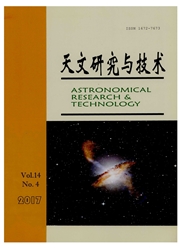

 中文摘要:
中文摘要:
程控自主天文台(Robotic Autonomous Observatory,RAO)是一架能够执行各种远程观测并且能够在任务执行过程中在没有任何人为协助的情况下自主适应各种变化的望远镜。使用程控自主天文台进行自主化观测,是近些年天文学观测模式新的重要发展方向。首先对程控自主天文台历史、现状、应用领域等做了回顾;然后重点介绍了一套程控自主天文台软件管理系统——RTS2;在此基础上对其代码结构进行详细分析,并且以一种小型赤道仪为实例,实现了在RTS2系统下驱动程序的设计。二次开发试验的成功为自行建设基于RTS2的程控自主天文台系统奠定了基础。
 英文摘要:
英文摘要:
A Robotic Autonomous Observatory (RAO) is a telescope that can perform various remote observations and adapt to changes during a task execution without human assistance. Currently, there are more and more RAO projects dedicated to follow-up observations of γ-ray bursts (GRBs) and supernovae. The RAO technology also shows more advantages as the time-domain astronomy develops. The software system plays a key role in an RAO system, since it is used to control the hardware devices and to schedule the entire observing process. The RTS2 (Remote Telescope System-2^nd version) is an open-source project aimed at developing a software environment to control a fully robotic observatory. It has been developed for more than 10 years. As the RTS2 project advances, many additional functions have been added, making the architecture of RTS2 more stable and mature. The RTS2 is based on the "plug and play" design. Each part of the system can be started, restarted, or stopped at anytime. Another highlight for the RTS2 is that there are dummy devices in an RTS2 system, providing a virtual environment for development tests. Due to the open-source and good-scalability characteristics, an RTS2 system is rather suitable for secondary developments to fit a new telescope. Nowadays, many RAO projects have installed RTS2 systems for the control of the telescopes. This paper first reviews the history and current situation of RAO, and then introduces our RTS2 software in detail. After that, the paper discusses the feasibility of a secondary development of an RTS2 system. The paper finally shows a design of a driving program for an RTS2 system to control a small equatorial (Synta NEQ6). This success lays the foundation for independent developing an RAO system based on the RST2.
 同期刊论文项目
同期刊论文项目
 同项目期刊论文
同项目期刊论文
 期刊信息
期刊信息
